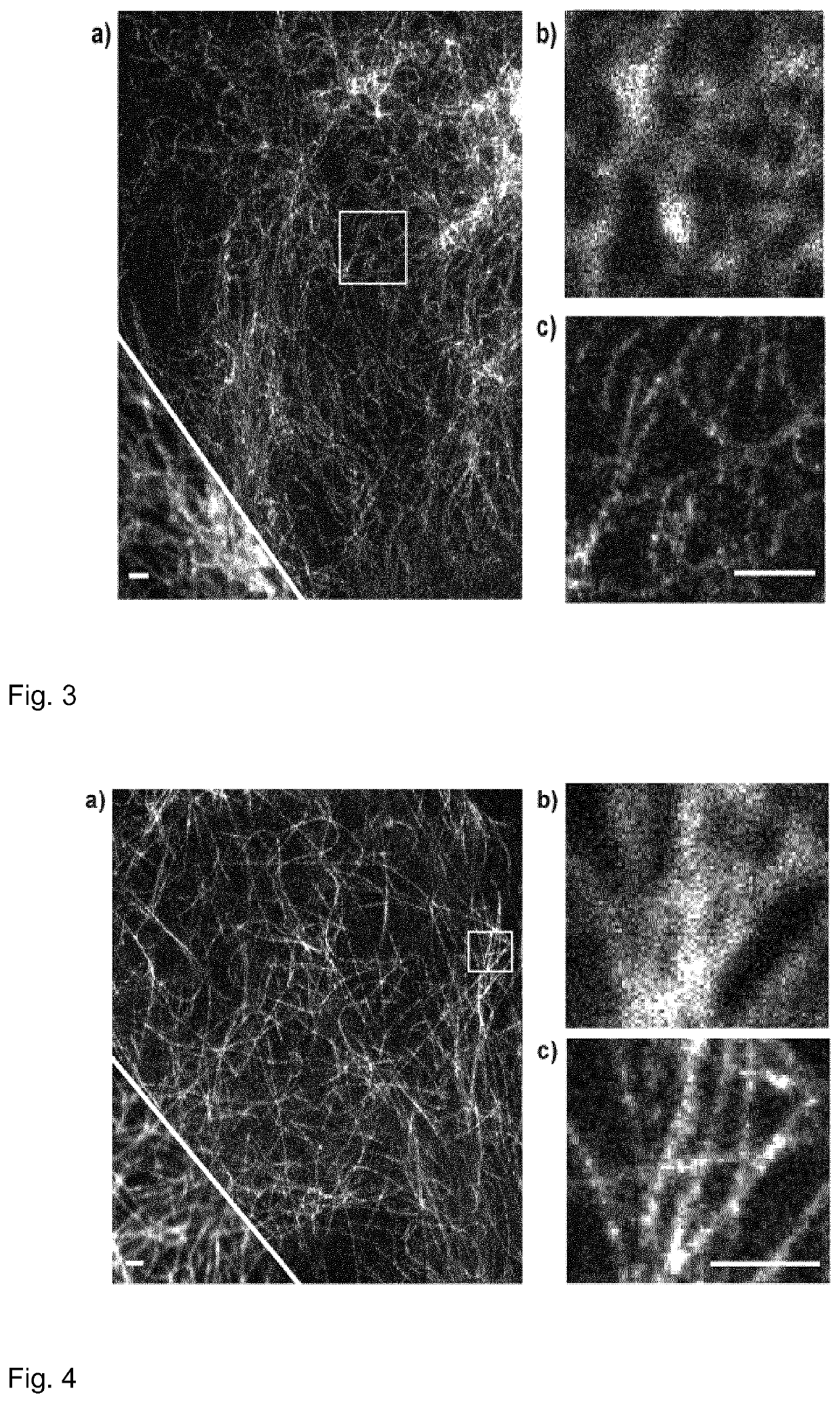Cell-penetrating fluorescent dyes with secondary alcohol functionalities
a fluorescent dye and secondary alcohol technology, applied in the field of cell penetrating fluorescent dyes with secondary alcohol functionalities, can solve the problems of difficult detection, less than desirable solubility of fluorescent dyes in aqueous media, and limited spectral variety of photostable fluorescent dyes suitable for intracellular targeting and super-resolution imaging in living cells
- Summary
- Abstract
- Description
- Claims
- Application Information
AI Technical Summary
Benefits of technology
Problems solved by technology
Method used
Image
Examples
example 1
Synthesis of Fluorescent Rhodamine Dyes and their Precursors
N,N′-Bis-(2,2,2-trifluoroethyl)-6′-carboxy-Q-rhodamine-β,β′-diol (5)
[0124]Compound 1-TBS.
[0125]A mixture of 3-(tert-butyldimethyl-silyloxy)aniline (prepared according to M. S. Hossain et al., Org. Biomol. Chem. 2015, 13, 5082-5085)(2.24 g, 10.0 mmol) and epichlorohydrin (0.94 g, 10.0 mmol) in acetic acid (20 mL) was stirred overnight at RT. The mixture was poured into aq. NaHCO3 (30 g in 300 mL water), extracted with ethyl acetate (3×50 mL), and the combined organic layers were washed with brine and dried over MgSO4. The product 1-TBS was isolated by flash column chromatography (Biotage SNAP Ultra 100 g; gradient 0% to 5% ethyl acetate—CH2Cl2) as light yellow oil, yield 0.84 g (27%). 1H NMR (400 MHz, CDCl3): δ 7.02 (t, J=8.0 Hz, 1H), 6.29-6.23 (m, 2H), 6.16 (t, J=2.2 Hz, 1H), 4.09-4.03 (m, 1H), 3.68 (dd, J=11.3, 4.5 Hz, 1H), 3.63 (dd, J=11.2, 6.1 Hz, 1H), 3.35 (dd, J=13.3, 4.4 Hz, 1H), 3.21 (dd, J=13.3, 7.1 Hz, 1H), 0.98 (s...
example 2
Synthesis of Ge-Rhodamine Dyes
Synthesis of Tetramethyl-Ge-Rhodamine 19
[0161]Compound 15.
[0162]A solution of 3-bromo-N,N-dimethylaniline (2.32 g, 11.6 mmol, 2 eq) in anhydrous THF (40 mL) was degassed on a Schlenk line and cooled to −78° C. under argon. n-butyllithium (5.1 mL of 2.5 M solution in hexanes, 12.76 mmol, 2.2 eq) was injected with a syringe quickly dropwise, and the mixture was stirred at −78 OC for 1 h. Dimethylgermanium dichloride (1.01 g, 5.8 mmol), dissolved in anhydrous THF (3 mL), was injected dropwise with a syringe. The mixture was allowed to warm up to RT and stirred for 2.5 h. Brine (50 mL) was then added, the mixture was extracted with ethyl acetate (3×40 mL), and the combined organic layers were dried over Na2SO4. TLC control (SiO2 / 10% ethyl acetate in hexane): Rf (product)=0.37. The product 15 was isolated by flash column chromatography (Biotage SNAP Ultra 50 g, gradient 1% to 10% ethyl acetate-hexane over 15 column volumes) as colorless oil, yield 1.56 g (78...
example iii
STED Optical Microscopy of Cells Using Exemplary Novel Dyes of the Invention
[0228]Dye 5: In order to provide a suitable STED wavelength (STED=stimulated emission depletion, method of the super-resolution optical microscopy providing the optical resolution beyond the diffraction limit), the 660 nm STED laser of the commercial Leica STED microscope, such as Leica TCS SP8 STED 3X, can be advantageously used. Indeed, the difference between the emission maximum and the STED wavelength is 100-170 nm (for the dyes with small Stokes shifts). FIG. 1 demonstrates the applicability in living cells and very good imaging performance of dye 5-OH in confocal and STED microscopy (applied as conjugate with Halo-Tag® amine,—compound 5-Halo in Scheme 2). Q-Rhodamine dye has absorption and emission maxima at 540 and 561 nm, respectively, while hydroxylated dye 5-OH—at 532 and 553 nm, respectively. The fluorescence quantum yield of dye 5-OH (0.89) is higher than the fluorescence quantum yield of Q-Rhoda...
PUM
| Property | Measurement | Unit |
|---|---|---|
| particle size | aaaaa | aaaaa |
| path length | aaaaa | aaaaa |
| size | aaaaa | aaaaa |
Abstract
Description
Claims
Application Information
 Login to View More
Login to View More - R&D
- Intellectual Property
- Life Sciences
- Materials
- Tech Scout
- Unparalleled Data Quality
- Higher Quality Content
- 60% Fewer Hallucinations
Browse by: Latest US Patents, China's latest patents, Technical Efficacy Thesaurus, Application Domain, Technology Topic, Popular Technical Reports.
© 2025 PatSnap. All rights reserved.Legal|Privacy policy|Modern Slavery Act Transparency Statement|Sitemap|About US| Contact US: help@patsnap.com



